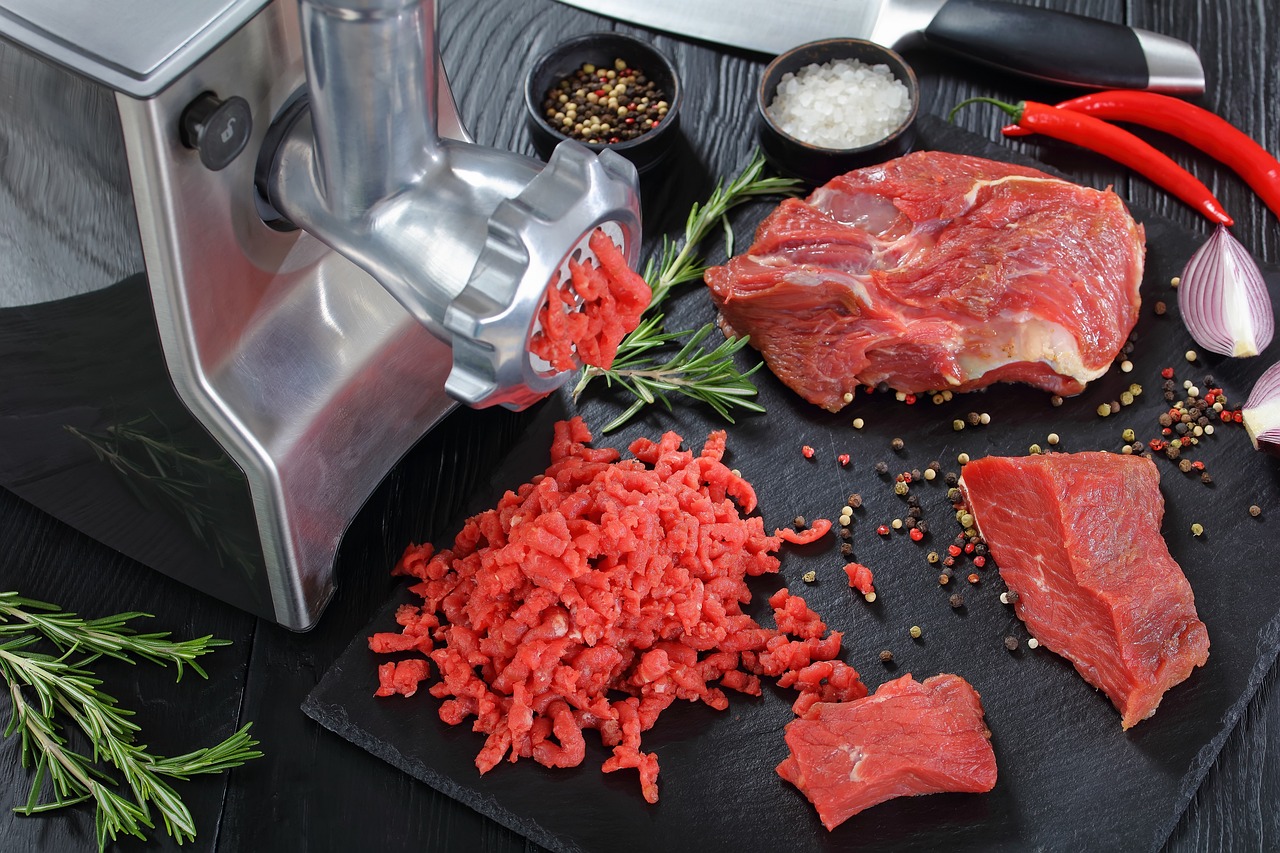The Fundamental Choice: Manual vs. Electric Meat Grinders
Choosing the right meat grinder is crucial for anyone serious about controlling the quality, texture, and safety of their ground meat, whether for burgers, sausages, or pet food. The decision often boils down to two primary types: the traditional, reliable manual (hand-crank) grinder and the powerful, efficient electric model. Each offers a distinct set of advantages and limitations that directly impact your grinding experience, volume capacity, and budget.
This comprehensive guide breaks down the core differences, performance metrics, and ideal use cases for both manual and electric meat grinders, ensuring you make an informed decision that aligns with your culinary goals in 2025.
Understanding the Manual Meat Grinder (The Hand Crank)
The manual meat grinder, often made of cast iron or stainless steel, is the classic choice. It operates entirely through human power, typically using a hand crank attached to an auger (worm gear) that pushes the meat through a cutting blade and then a grinding plate.
Key Attributes and Mechanics
Manual grinders are characterized by their simplicity. They require no electricity, making them highly portable and reliable. They are typically secured to a countertop using a clamp or suction base. The grinding speed is entirely dependent on the user’s effort and pace.
Advantages of Manual Grinding
- Cost-Effectiveness: Manual grinders are significantly cheaper upfront than their electric counterparts, often costing less than $50 for a durable model.
- Temperature Control: Because the grinding process is slower, less friction and heat are generated. This is critical for maintaining the meat’s temperature below 40°F (4°C), which is vital for food safety and achieving the best texture, especially when preparing grinder meat preparation safety equipment.
- Portability and Reliability: They can be used anywhere—camping, hunting cabins, or during power outages—without needing an electrical outlet.
- Quiet Operation: The only noise produced is the sound of the meat being processed, making for a much quieter kitchen environment.
Disadvantages and Limitations
- High Effort Requirement: Grinding large volumes of meat requires considerable physical effort and time, leading to fatigue.
- Slow Processing Speed: They are impractical for processing large batches, such as a whole deer or several pounds of sausage meat.
- Limited Features: Manual models generally lack specialized attachments found on electric models, though some do offer basic sausage stuffing tubes.
Exploring the Electric Meat Grinder (The Motorized Solution)
Electric meat grinders are designed for speed, volume, and convenience. They utilize a powerful motor to drive the auger, automating the entire grinding process.
Core Components and Power
Electric grinders are defined by their motor specifications, typically measured in watts or horsepower (HP). Key factors include:
- Motor Size: Higher wattage (e.g., 500W to 2000W) translates to greater torque and the ability to handle tougher cuts, sinew, and even small bones (in commercial-grade models).
- Gearing: Quality electric grinders use metal gears (often steel) rather than plastic, ensuring durability and longevity under heavy load.
- Size Numbers: Grinders are often categorized by size (e.g., #5, #8, #12, #22, #32), which corresponds to the diameter of the grinding plate and the overall processing capacity.
Advantages of Electric Grinding
- Speed and Efficiency: Electric grinders can process pounds of meat in minutes, making them ideal for hunters, serious sausage makers, or those who buy meat in bulk.
- Consistency: The constant, uniform speed of the motor ensures a highly consistent grind texture, which is crucial for professional-grade sausage making.
- Reduced Effort: The user simply feeds the meat into the hopper; the machine does the heavy lifting.
- Versatility: Many electric models come with numerous attachments, including sausage stuffers, kubbe attachments, and specialized plates for fine or coarse grinds. For those interested in material quality, high-end electric models are often made of durable stainless steel meat grinders guide.
Disadvantages and Considerations
- Higher Initial Cost: Quality electric grinders start at $150 and can easily exceed $500 for heavy-duty models.
- Noise: The powerful motors can be quite loud, especially when processing tough or frozen meat.
- Heat Generation: If operated continuously for long periods, the motor and auger can generate heat, potentially warming the meat above the safe temperature zone. This necessitates careful meat chilling and often requires the user to chill the grinder components before use.
- Maintenance Complexity: If the motor or electrical components fail, repairs are often more complex and costly than replacing a manual part.
Performance Comparison: Speed, Volume, and Consistency
The primary difference between the two types lies in their operational capacity and output quality.
| Feature | Manual Meat Grinder | Electric Meat Grinder |
|---|---|---|
| Processing Speed | Slow (User-dependent) | Fast (Motor-dependent) |
| Volume Capacity | Low (1-5 lbs per session) | High (10+ lbs per session) |
| Consistency | Good, but variable with user fatigue | Excellent, highly uniform |
| Tough Cuts/Sinew | Requires pre-trimming, can jam | Handles tough cuts easily (with sufficient motor power) |
| Temperature Risk | Low (Slower speed = less friction) | Moderate (Requires chilling components) |
Processing Capacity by Grinder Type
For the casual home cook preparing 2-3 pounds of meat for dinner, a manual grinder is perfectly adequate. However, if you are a hunter processing a deer or a serious hobbyist making 10-20 pounds of sausage mix, an electric grinder (size #12 or larger) is essential for efficiency and preventing meat spoilage due to prolonged processing time.
Consistency of Grind
Electric grinders offer superior consistency because the motor maintains a steady RPM (revolutions per minute). This is vital for recipes like emulsified sausages, where uniform particle size is necessary for proper binding and texture. While manual grinders can achieve a good grind, consistency may suffer as the user tires.
Temperature Control and Meat Quality
Maintaining a low temperature is the single most important factor in meat grinding. Warm meat smears, resulting in a mushy texture and increased risk of bacterial growth. While manual grinders generate less friction, they take longer, potentially exposing the meat to ambient heat. Electric grinders, while generating more friction, process the meat so quickly that the overall exposure time is minimized, provided the meat and grinder components are thoroughly chilled beforehand.
Cost Analysis: Initial Investment and Long-Term Value
When comparing the cost of a manual vs. electric meat grinder, consider both the initial purchase price and the long-term operational costs.
- Manual Grinders: Initial cost is low ($20–$100). Long-term costs are minimal, limited to replacement blades or plates.
- Electric Grinders: Initial cost is moderate to high ($150–$600+). Long-term costs include potential motor repair, replacement gears, and electricity consumption. However, the value derived from time saved and increased capacity often justifies the higher investment for high-volume users.
If you plan to grind meat weekly or process game seasonally, the electric model offers superior long-term value due to its efficiency and reduced physical strain.
Durability, Maintenance, and Longevity
Cleaning and Care (Manual vs. Electric)
Cleaning is a critical aspect of Care & Maintenance.
- Manual: Generally easier to clean. Components are fewer and often dishwasher-safe (if stainless steel). Cast iron models require immediate hand-washing and thorough drying to prevent rust.
- Electric: Requires careful disassembly. Components that touch the meat (auger, housing, plates) must be washed by hand and dried immediately. The motor housing must never be submerged.
Parts and Repair
Manual grinders are inherently more durable because they have no complex moving parts to fail. A manual grinder made of quality stainless steel can last for decades with minimal maintenance. Electric grinders rely on the motor and gearing. While high-end models are built to last, a motor burnout can render the entire unit useless or require expensive professional repair.
Who Should Choose Which Grinder? (User Profile Matching)
The Casual Home Cook (Low volume)
If you only grind 1–2 pounds of meat occasionally for specific recipes and value counter space and quiet operation, a manual meat grinder is the ideal, cost-effective choice. It offers excellent control for small batches.
The Serious Hunter or Sausage Maker (High volume, specific needs)
If you process large quantities of game, make sausage regularly, or require consistent, high-speed output, an electric meat grinder (size #12 or larger) is necessary. The investment pays for itself in time and effort saved.
The Off-Grid or Emergency Prepper (Portability)
For situations where electricity is unavailable or unreliable, the manual hand crank meat grinder is the only viable option. Its simplicity ensures operation regardless of external power sources.
Making the Final Decision: Is a Manual or Electric Meat Grinder Better?
The question of whether a manual or electric meat grinder is better depends entirely on your intended use:
- Choose Manual if: You prioritize low cost, portability, quiet operation, and only process small volumes (under 5 lbs) infrequently.
- Choose Electric if: You prioritize speed, high volume capacity, consistency, and are willing to invest more for automated convenience.
For most modern kitchens that process 5-10 pounds of meat monthly, a mid-range electric grinder (#8 size) offers the best balance of power, speed, and affordability.
Enhance Your Grinding Skills
Ready to elevate your meat preparation? Understanding the nuances of Grinding Techniques is key to maximizing the performance of your chosen grinder. Explore our guides on proper meat chilling, plate selection, and double grinding methods to achieve professional results every time.
Frequently Asked Questions (FAQ)
Q: Can I grind bones in an electric meat grinder?
A: Only commercial-grade or very heavy-duty electric grinders (typically size #22 or #32 with high horsepower) are designed to handle soft bones, such as chicken necks or small poultry bones, for pet food. Never attempt to grind large, dense bones (like beef or pork leg bones) in a standard home electric or manual grinder, as this will damage the machine and potentially void the warranty.
Q: How do I prevent rust on my cast iron manual grinder?
A: Cast iron must be cleaned immediately after use with hot, soapy water, rinsed thoroughly, and dried completely. Once dry, wipe all metal surfaces with a light coating of food-grade mineral oil or cooking spray before storage. This seasoning process prevents oxidation.
Q: What is the difference between a meat grinder and a food processor?
A: A meat grinder uses an auger, blade, and plate system to cut the meat into uniform particles, preserving the texture and structure necessary for sausages and burgers. A food processor uses spinning blades to chop the meat, which often results in a paste-like, smeared texture due to excessive friction and heat. For quality ground meat, a dedicated grinder is always superior.
Q: What size electric grinder is best for a home hunter?
A: A home hunter who processes one or two deer per season should look for a size #12 electric grinder. This size offers a good balance of motor power and throughput speed necessary to process large volumes efficiently while maintaining meat temperature.
References
- Food Safety and Inspection Service (FSIS). Safe Minimum Internal Temperature Chart. 2025. — This resource emphasizes the critical importance of maintaining low temperatures during meat processing to prevent bacterial growth.
- Consumer Reports. Review of High-Power Electric Meat Grinders for Home Use. 2025. https://www.consumerreports.org/ — This article provides performance data on motor wattage, gear durability, and processing speed across various electric meat grinder models available in the current market.
- National Center for Home Food Preservation. Techniques for Safe Meat Grinding and Sausage Preparation. 2025. https://nchfp.uga.edu/how/can_05/sausage_making.html — This guide details best practices for chilling meat and equipment, proper sanitation, and optimal grinding techniques to ensure high-quality, safe results at home.
Last Updated on October 14, 2025 by Robert Vance

